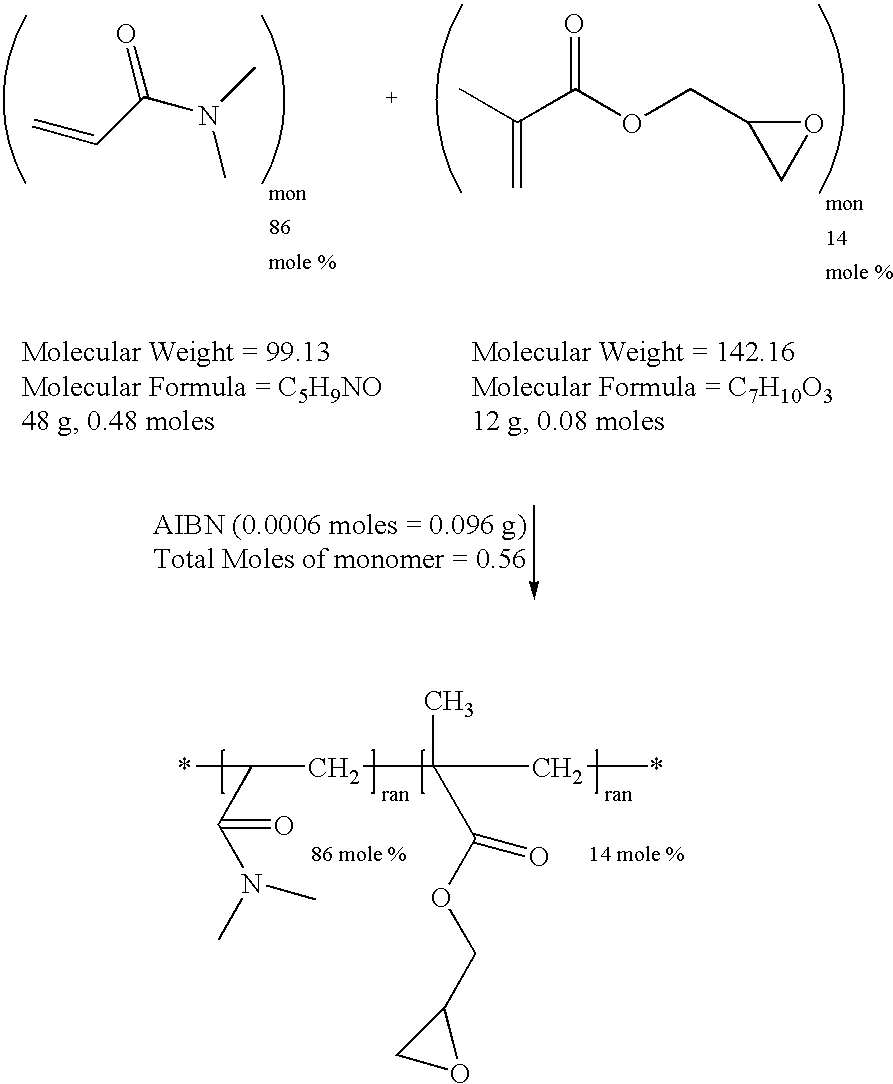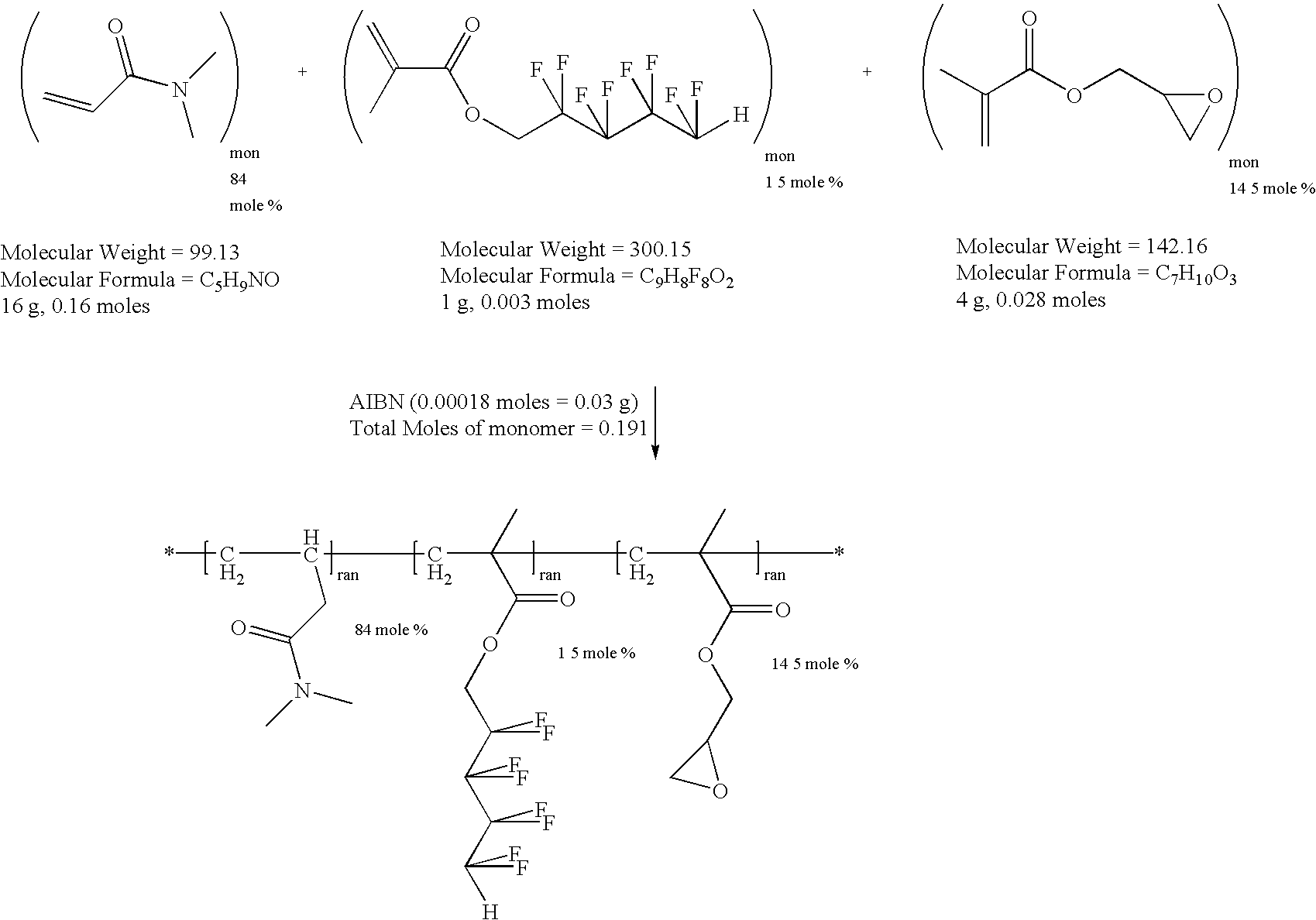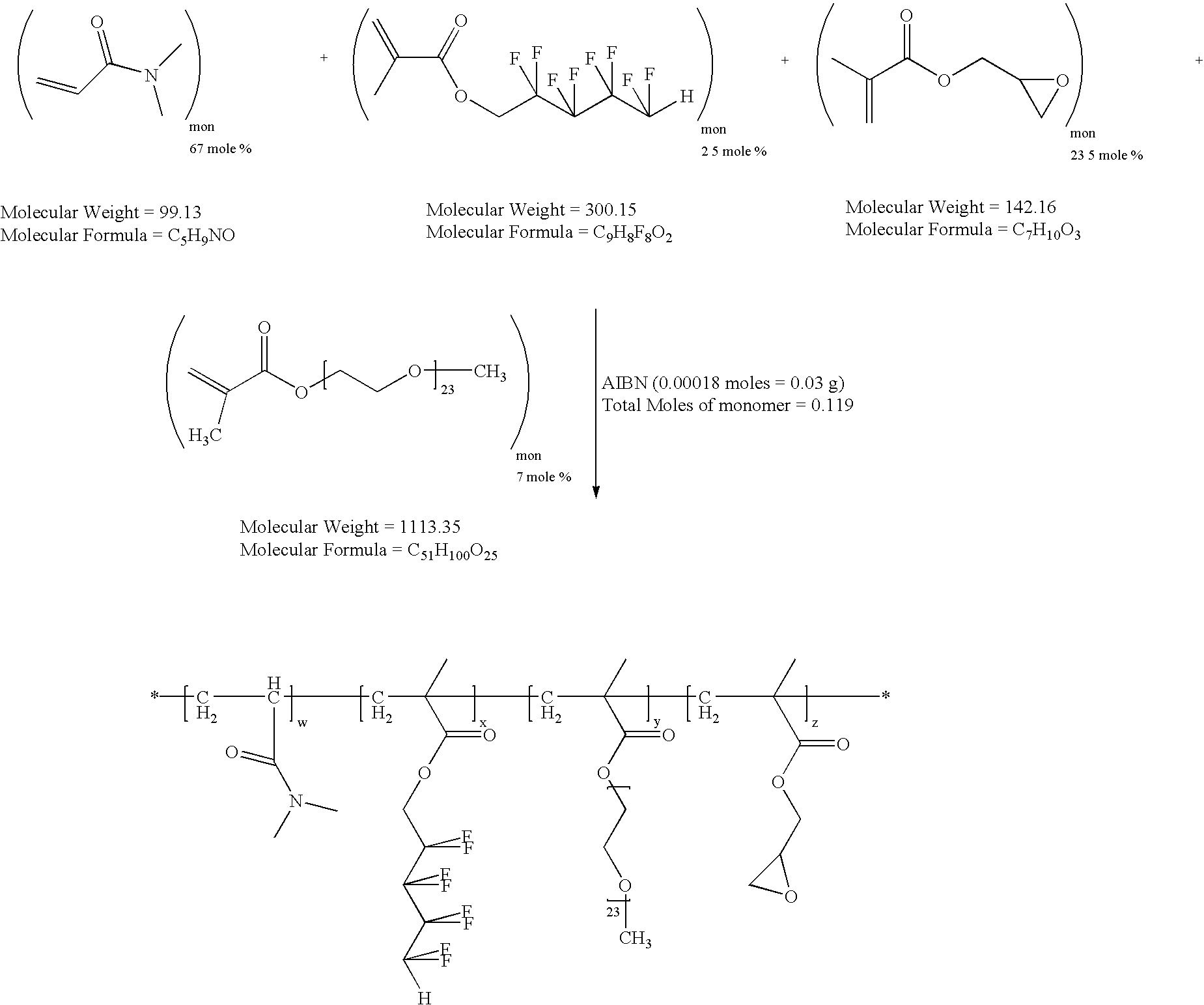Surface modification of functional group-containing medical devices with catalyst-containing reactive polymer system
a reactive polymer and functional group technology, applied in the field of surface modification of functional group-containing polymeric materials, can solve the problems of less popularization of more rigid iol implants in the market, increased incidence of postoperative complications, undesirable iol opacification, etc., to reduce or eliminate silicone oil absorption, reduce the cost of associated with coating, and simplify the coating process
- Summary
- Abstract
- Description
- Claims
- Application Information
AI Technical Summary
Benefits of technology
Problems solved by technology
Method used
Image
Examples
example 1
Synthesis of Reactive, Hydrophilic Copolymer of N,N-dimethylacrylamide (DMA) and Glycidyl Methacrylate (GMA)
[0029]
[0030]To a one liter reaction flask were added distilled N,N-dimethylacrylamide (DMA, 48 gm, 0.48 moles), distilled glycidyl methacrylate (GMA, 12 gm, 0.08 moles), 2,2′-azobisisobutyronitrile (AIBN, 0.096 gm, 0.0006 moles) and toluene (600 ml). The reaction vessel was fitted with a magnetic stirrer, condenser, thermal controller and a nitrogen inlet. Nitrogen was bubbled through the solution for 15 minutes to remove any dissolved oxygen. The reaction flask was then heated to 60° Celsius under a passive blanket of nitrogen for twenty hours. The reaction mixture was then added slowly to six liters of ethyl ether with good mechanical stirring. The reactive polymer precipitated and was collected by vacuum filtration. The solid was placed in a vacuum oven at 30° Celsius overnight to remove the ether leaving 50.1 gm of reactive polymer (an 83 percent yield). The reactive poly...
example 2
Synthesis of a Water Soluble Reactive Polymer of N,N-dimethylacrylamide (DMA), 1H,1H,5H-octafluoropentyl Methacrylate (OFPMA) and Glycidyl Methacrylate (GMA)
[0033]
[0034]To a 500 ml reaction flask were added distilled N,N-dimethylacrylamide (DMA, 16 gm, 0.16 moles), 1H,1H,5H-octafluoropentyl methacrylate (OFPMA, 1 gm, 0.003 moles, used as received), distilled glycidyl methacrylate (GMA, 4 gm, 0.028 moles), 2,2′-azobisisobutyronitrile (AIBN, 0.03 gm, 0.00018 moles) and toluene (300 ml). The reaction vessel was fitted with a magnetic stirrer, condenser, thermal controller and a nitrogen inlet. Nitrogen was bubbled through the solution for 15 minutes to remove any dissolved oxygen. The reaction flask was then heated to 60° Celsius under a passive blanket of nitrogen for twenty hours. The reaction mixture was then added slowly to 3 liters of ethyl ether with good mechanical stirring. The reactive polymer precipitated and was collected by vacuum filtration. The solid was placed in a vacu...
example 2f
Synthesis of Reactive, Hydrophilic Copolymer of N,N-dimethylacrylamide (DMA), 1H,1H,5H-octafluoropentyl Methacrylate (OFPMA), Glycidyl Methacrylate (GMA) and Polyethylene Glycol 1000 Monomethylether Methacrylate (PEGMA)
[0037]
[0038]To a 500 ml reaction flask were added distilled N,N-dimethylacrylamide (DMA, 8 g, 0.08 moles), 1H,1H,5H-octafluoropentyl methacrylate (OFPMA, 1 g, 0.003 moles, used as received), distilled glycidyl methacrylate (GM, 4 g, 0.028 moles) polyethylene glycol 1000 monomethyl ether methacrylate (PEGMA, 8 g, 0.007 moles), 2,2′-azobisisobutyronitrile (AIBN, 0.03 g, 0.00018 moles) and tetrahydrofuran (THF, 300 ml). The reaction vessel was fitted with a magnetic stirrer, condenser, thermal controller and a nitrogen inlet. Nitrogen was bubbled through the solution for 15 minutes to remove any dissolved oxygen. The reaction flask was then heated to 60° C. under a passive blanket of nitrogen for 72 hours. Flash evaporation of the solvent followed by freeze drying left ...
PUM
| Property | Measurement | Unit |
|---|---|---|
| elongation | aaaaa | aaaaa |
| refractive index | aaaaa | aaaaa |
| refractive index | aaaaa | aaaaa |
Abstract
Description
Claims
Application Information
 Login to View More
Login to View More - R&D
- Intellectual Property
- Life Sciences
- Materials
- Tech Scout
- Unparalleled Data Quality
- Higher Quality Content
- 60% Fewer Hallucinations
Browse by: Latest US Patents, China's latest patents, Technical Efficacy Thesaurus, Application Domain, Technology Topic, Popular Technical Reports.
© 2025 PatSnap. All rights reserved.Legal|Privacy policy|Modern Slavery Act Transparency Statement|Sitemap|About US| Contact US: help@patsnap.com



